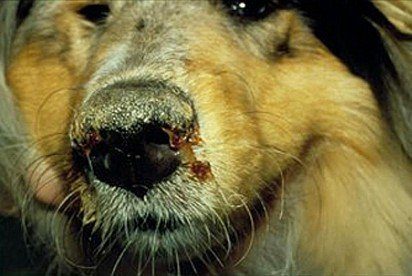
Distemper amin'ny alika: famantarana, soritr'aretina, fitsaboana any an-trano
Hevitra ato Anatiny
- Causes of distemper in dogs
- Where can a dog get distemper?
- Mekanisma ny fivoaran'ny aretina
- Initial symptoms of distemper in dogs
- Further development of the disease: forms of distemper
- Diagnostics
- Treatment
- fisorohana
- Which dogs are at risk
- Is distemper transmitted in dogs to humans or other animals?
- Can there be complications of distemper in dogs?
Causes of distemper in dogs
The development of distemper in dogs occurs for one, only reason – the penetration into the body of an animal of a highly contagious virus belonging to the family of paramyxoviruses. It is characterized by the following features:
- capable of very rapid reproduction;
- has a strong pathogenic effect on the body;
- can affect several organ systems at once or some specific one;
- remains active in the physiological secretions of a sick dog for a week, and under favorable conditions even more.
After the virus enters the body of the animal, the dog itself becomes its carrier and source of infection.
Where can a dog get distemper?

A dog infected with distemper. Note purulent discharge and hyperkeratotic nose.
A dog can get distemper anywhere, even at home. The source of infection is the excretion of another animal – the carrier of the virus. The virus can enter the body of a healthy pet in two ways: through the digestive tract and the respiratory system, so almost any object is dangerous, not to mention direct contact with a sick dog. It:
- feces, discharge during estrus, saliva, etc.;
- booth, aviary;
- lovia iray;
- pad and so on.
The owner himself can “bring” the distemper infection into the house, for example, on shoes. In the same way, cats can transmit the virus if they walk down the street, but come home to sleep.
Mekanisma ny fivoaran'ny aretina
After the distemper virus has entered the body of the animal, it begins to actively multiply. The owner will not immediately determine that his pet is sick. The first days the dog is in its usual state. The latent period of virus reproduction can be an average of a week, but sometimes two or even three. It is very rare that the signs of the disease appear 2-3 days after contact between a healthy and infected dog. This is possible only if the animal has practically no immunity.
Note: A dog that has been ill with distemper remains immune to the virus for life.
After the incubation period has passed, and the virus has multiplied sufficiently, the first signs of the disease appear.
Initial symptoms of distemper in dogs
How does the distemper of dogs manifest itself at the initial stage? The most common primary symptoms include:
- fahalainana;
- depressed look;
- mamontsina sy mena ny maso;
- volon'ondry misavoritaka;
- sensitivity to light (the dog starts looking for a darker place);
- aretina amin'ny trakta fandevonan-kanina;
- mucous discharge from the nose and eyes.
Not all animals exhibit these traits to the same extent. Their severity depends on the state of immunity, lifestyle, age and other factors. In addition, some symptoms of distemper may predominate, or others may be added to those listed (for example, fever). Of great importance is also which organ system is most affected by the virus.
Further development of the disease: forms of distemper
Symptoms of distemper in dogs are rarely observed in isolation, as the virus infects the entire body. However, on the basis of those that are most pronounced, several forms of the disease are conventionally distinguished.
ny havokavoko
The animal’s body temperature rises, a cough occurs. The discharge from the eyes and nostrils is purulent. The dog refuses to eat, consumes a lot of water. Gradually join diarrhea and vomiting.
natahotra
The animal is tormented by intense thirst. Characterized by muscle twitches. There is irritability, aggressiveness. In the absence of treatment, the hind limbs are paralyzed, epilepsy is observed. With paralysis of the heart and lung muscle fibers, the dog dies.
tsinay
The pet does not take food, is very weakened, up to loss of consciousness. The surface of the tongue acquires a white tint due to plaque. The animal suffers from vomiting and diarrhea. In the latter case, the discharge is yellowish.
Ny tsirairay
Rashes appear on the body of the pet, later pustules and sores form from them. If an infection gets into them, then severe inflammation occurs. Despite the fact that this form of the disease is considered the easiest in terms of prognosis, if left untreated, the pet may die from exhaustion.
In addition to classification according to the clinical picture, several forms of distemper in dogs are distinguished based on the duration of the disease.
- Lightning. Symptoms almost do not appear, but the animal dies within a day.
- Super sharp. There is a very high temperature. The animal refuses food. Death occurs on the second or third day.
- Acute. It is characterized by the above symptoms.
- Chronic. Periods of remission alternate with relapses. The duration of the disease is up to several months.
Attention! If any deviations in the behavior or condition of the dog appear, you should immediately contact the veterinarian and take tests.
Diagnostics
After listening to complaints from the owner and an external examination of the dog, the specialist will definitely prescribe laboratory diagnostics. In most cases, the study will require taking blood, swabs from the eyes (nose, mouth).
To identify the virus and determine its type, it is possible to use methods such as:
- enzyme immunoassay (ELISA) – allows you to identify the disease at an early stage;
- polymerase chain reaction (PCR) – also has high sensitivity;
- susceptibility test;
- tests for the determination of an antigen in the blood of a dog;
- neutralization reaction – carried out to determine the species.
To date, there are many other laboratory diagnostic methods that can detect the distemper virus in the tissues of a dog. The choice of one or another method is within the competence of a specialist.
Treatment
Treatment of distemper in dogs should be comprehensive, including both the use of medications and additional funds. The direction of therapy depends on the clinical picture and the general condition of the dog. It is impossible to independently prescribe medicines to an animal or treat it only with folk “proven” methods. A treatment plan for canine distemper should be drawn up by a qualified specialist.
Fitsaboana manokana
Specific methods of treating distemper in dogs include transfusion of blood from a dog that has been ill with distemper, as well as the introduction of serum. The first method is rarely used, the second is the most popular. Serum is pre-treated blood taken from a dog already immune to the virus. Thus, it is saturated with antibodies to infection. It is administered three times, 1-2 times a day (according to the condition of the dog). Serums most often used are: Giksan, Globkan, Avirokan.
However, the production of serum may not always help, but only at the beginning of the development of the disease. The later the owner turned to the clinic, the less chance the pet has to recover.
Fitsaboana simptetika
In each individual case, the specialist will prescribe certain drugs aimed at eliminating the symptoms of the disease or preventing them. The form of medicines (tablets, injections, solutions for external treatment, etc.) is also individual. Some examples of conditions (symptoms) and remedies are given in the table below.
Fanelingelenana ny CNS
Aminazine
Aretin'ny bakteria
Gentamicin
Aretim-po
Sulfocamphocaine
Ny hery fiarovan'ny vatana
Immunofan
mamo
Ringer’s solution
In parallel, the intake of B vitamins is indicated.
The duration of treatment for distemper in dogs is individual in each case.
Fomba fanaon'ny vahoaka
Simultaneously with the main treatment for distemper in dogs, the use of alternative methods is allowed, which must first be agreed with the veterinarian. For example, decoctions and infusions of medicinal plants can be used to speed up the removal of toxins from the body, prevent inflammatory processes, strengthen the immune system, and for other purposes. It can be: chamomile, motherwort, St. John’s wort and so on.
Quite common is the advice on how to treat distemper in dogs with vodka. To do this, 100 ml of an alcoholic drink is mixed with 20 g of honey and a raw chicken egg. The composition is well stirred and poured into the dog using a rubber “pear”.
When using folk methods and methods, the owner should not forget that the outcome of treatment is determined by the state of the pet’s immunity. If the dog has a strong immune system, then it is quite possible that she will be able to cope with the disease only on decoctions or vodka. With low immunity, such measures can not only not help, but also aggravate the situation, lead to death.
Fepetra fanampiny
Treatment of distemper at home involves the adoption of additional measures.
- The dog must be in a clean room, on a dry and regularly processed bedding.
- The bowl from which the animal eats and drinks should also be washed and disinfected regularly.
- Since the plague is characterized by a fear of bright light, it is better to shade the place where the pet is located.
- In the presence of secretions, sores, their location should be carefully treated with antiseptics.
You will need to pay attention not only to the location of the dog, but also to its diet. On the first day of the disease, it is preferable to keep the pet on hunger, at least half a day. From the second day, you can enter a liquid diet, such as cereal soups. It is allowed to add minced meat, pieces of raw meat, an egg to them. You can give the animal various decoctions of medicinal herbs. Clean water should always be nearby.
fisorohana
Vaccination is the most important preventive measure to keep your dog from getting sick. The first time the distemper vaccine is given in puppyhood older than 3 months. After that, vaccination will need to be carried out once every year.
Of great preventive importance is the state of the pet’s immune system. The better the immune system, the lower the risk of infection and the higher the likelihood of a quick recovery in case of illness. To strengthen the defenses of the dog will help the simple principles of its content:
- clean bedding and bowl;
- complete nutrition;
- periodic introduction of vitamin complexes into the feed;
- regular walks.
Washing the paws upon arrival from the street will also help protect the animal from distemper, if the dog lives with the owner in the same room. In addition, you need to avoid dubious “acquaintances” of your four-legged friend, do not let go of the leash and do not leave unattended.
Which dogs are at risk
Any dog can get distemper, regardless of age or breed. To a greater extent, the likelihood of infection threatens those four-legged friends who have weakened immunity. These can be dogs recovering from another illness or injury, homeless yard animals, with weakened immune systems from malnutrition and lifestyle. In addition, a high percentage of morbidity is recorded among puppies that have not reached the age of one. Puppies that are breastfed usually do not get sick with canine distemper.
There are different degrees of distemper risk for dogs of different breeds. So, terriers and mongrels are considered more resistant to the virus. Often, owners of shepherd dogs who are quite difficult to tolerate this disease turn to veterinarians. The highest probability of getting sick with distemper is in dogs belonging to hunting breeds and regularly leading a destined lifestyle. This is due to the fact that wolves, foxes, and some other wild animals also get sick with the distemper virus.
Is distemper transmitted in dogs to humans or other animals?
No, canine distemper is not transmitted to humans. Cats cannot get it either. The virus can only be transmitted to another dog, as well as to wild animals (foxes, ferrets, and others).
Can there be complications of distemper in dogs?
Unfortunately, a fifth of dogs who have had distemper develop complications. They can be of a different nature: from minor to serious. What exactly the consequences can be depends on the form of the disease. For example, intestinal leads to the development of chronic diseases of the gastrointestinal tract (colitis, enteritis), pulmonary causes pathologies of the heart, lungs, and stomach. A common complication of distemper in dogs is paralysis of the hind limbs.
Only a timely appeal to a veterinarian can be the key to preventing the development of complications of distemper and the death of a dog!





